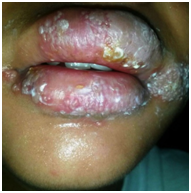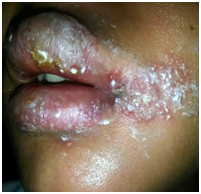Journal of
eISSN: 2574-9943


Essential granulomatous cheilitis is the most common monosymptomatic manifestation of Melkersson-Rosenthal syndrome and its chronic and progressive idiopathic orofacial granulomatosis of rare onset and benign nature. There is a male school with the condition showing favorable therapeutic response with oral diaminodiphenyl sulfone and topical corticosteroid at 3 months of management.
Keywords: granulomatous cheilitis, melkersson rosenthal syndrome, dermatoses; crohn's disease, DDS
Originally described by Miescher in 1945, the essential granulomatous cheilitis is a progressive chronic inflammatory pathology of unknown etiology and exceptional presentation. The monosymptomatic form of Melkersson-Rosenthal syndrome is considered in which there is an increase in the volume of one or both lips with variable extension towards the cheeks. The characteristic clinical triad observed in 25-40% of the cases is complemented with "scrotal" or folded tongue, and recurrent peripheral facial paralysis. In 1985 Wiesenfield coined the term noninfectious orofacial granulomatosis of the lips, oral cavity, and face; this rare pathology may include Crohn's disease and sarcoidosis. Probably a denomination that unifies several entities of origin, pathophysiology and very different clinical findings.1-3
It is attended to an 8-year-old male patient who suffers localized dermatosis on the head affecting the lower third of the face, which is characterized by evident swelling that is reluctant to the occasionally ardent touch of both lips associated with adherent and dry escamocostrosos elements of whitish-yellowish tint as well as fissures. Evolution 2 weeks, rapidly progressive course that makes difficult the management of salivation and swallowing (Figures 1 & 2). The presence of bilateral irritative keratoconjunctivitis with congestive erythema, lacrimation and photophobia is also evident. As an additional finding it is manifest folded or scrotal tongue. Their parents claim to constitute the third plurilesional attack at a 6-8 month interval with slow clinical resolution. It was previously attended by a physician who prescribed mild preparations with chamomile water in addition to topical acyclovir 4 times a day and systemic route at the usual dosage for 3 weeks without a favorable therapeutic response.4,5


Figures 1 & 2 Disfiguring edematous swelling, with fissures and exudative activity with vesicoampules, and adherent scales and crusts elements.
The patient was enrolled requesting general studies including complete blood biometry, blood chemistry, pharyngeal exudate, and general examination of urine, all within normal parameters. Due to the nature and long and repeated course of the clinical picture and to failure with the local and systemic antiviral therapy used on several occasions, it is decided with the parents to perform a lesion biopsy for anatomopathological analysis.
We report a granulomatous infiltrate of lymphoplasmacyte cells distributed in sarcoid and tuberculoid patterns; Accompanied by interstitial edema and perivascular lymphocytic infiltrate in the superficial and middle dermis (Figure 3).
Following the clinicopathological correlation, the diagnosis of granulomatous cheilitis of Miescher was determined. Oral treatment with diamonodiphenylsulfone (DDS) is initiated at a rate of 50 mg daily in a single intake for 3 months, as well as secant fomentation with copper sulfate and zinc 3 times a day with subsequent local application of hydrocortisone 1% cream morning And night for the same period of time. Significant improvement at the end of treatment without subsequent recurrence was observed at periodic medical visits of control over a 2-year period (Figure 4).
Tilakaratne et al.6 emphasize that the term idiopathic orofacial granulomatosis should be accepted in cases of exclusive muco-occult involvement without evidence of multisystem involvement. However, some authors consider the clinical and histopathological similarities of entities such as sarcoidosis, Crohn's disease, chronic ulcerative colitis, Melkersson-Rosenthal syndrome and idiopathic orofacial granulomatosis, among others, promoting the unifying concept of the same, with mono presentations And oligosymptomatic. There are multiple therapeutic modalities proposed with very variable results in ignoring the etiopathogenic mechanisms raised in its development. Thus, non-steroidal anti-inflammatory drugs, mast cell stabilizers, clofazimine, thalidomide, colchiquine, hydroxychloroquines, diaminodiphenylsulfone, erythromycin, tetracyclines, metronidazole and methotrexate have been used. Oral or intralesional corticosteroids are less effective and topical are useful drugs for symptomatic control and are almost always complemented with the above-mentioned medications to reduce the potential risk of their expected side effects. Radiotherapy and macrochial repair surgery may represent more aggressive alternatives that are not definitive given the slowly progressive evolution of the disorder. Like Pigozzi, it was decided to add to the treatment instituted with local steroids and diaminodiphenylsulfone orally for its antimicrobial and anti-inflammatory action with favorable response after several months of therapy and periodic monitoring.6-8
None.
The author declares no conflicts of interest.

© . This is an open access article distributed under the terms of the, which permits unrestricted use, distribution, and build upon your work non-commercially.